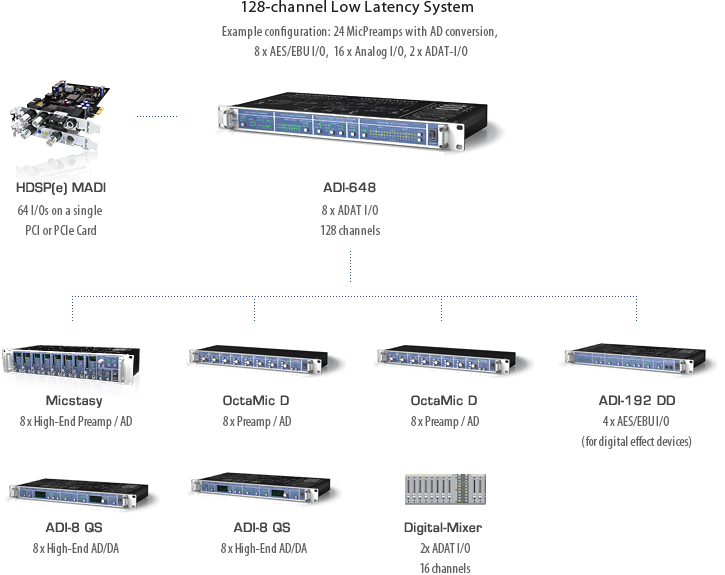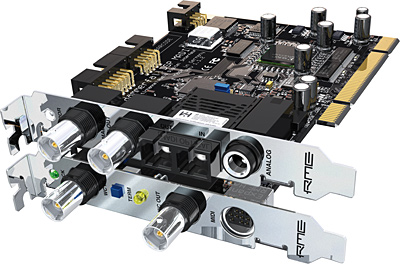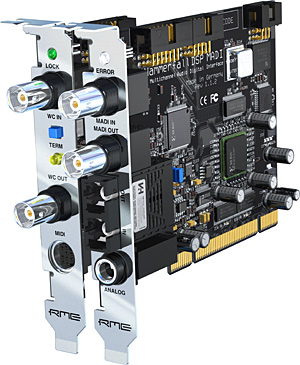MADI & AES/EBU Series
- Overview
- HDSPe MADI FX
- HDSPe MADI
- HDSPe AES
- MADIface XT
- MADIface USB
- MADIface Pro
- M-32 / M-16 AD
- M-32 / M-16 DA
- M-32 Pro
- ADI-642
- ADI-6432/ADI-6432R
- ADI-6432R BNC
- ADI-648
- MADI Router
- MADI Converter
MADI Info Center
RME HDSPe MADI
Studiomagazin 12/2003 „... the most innovative I/O solution at this time...”
Overview
Connectivity
- PCI Express Interface
- 64 Input channels / 64 Output channels
- 1 x MADI I/O (optical and coaxial)
- 2 x MIDI I/O
- Stereo Analog Out
- Word Clock I/O
- TotalMix
- optional: HDSP TCO
Differences to HDSP MADI
The HDSPe MADI is RME's both inexpensive and outstanding PCI Express card with MADI interface. HDSPe MADI is based on the award-winning HDSP MADI card, and represents the new top model of this world-wide successful card line.
The PCI Express card consequently uses all advantages of the MADI format, the professionals' multi-Channel audio interface, offering 64 channels of 24-bit audio at a sample rate of up to 48 kHz, 32 channels at up to 96 kHz and 16 channels at up to 192 kHz. Transmission is done via a single line, either coaxial with BNC plugs or by fiber cable. In both cases more than 100 m cable length can be achieved.
Compared with the HDSP MADI (Standard PCI version), the express card offers some new features: Support of higher sample rates than 96 kHz, more features in TotalMix (phase and internal loopback per channel, +6 dB gain for the hardware outputs), and the direct support of the Time Code Option. HDSPe MADI provides even lower latencies, making the card the perfect partner for live recording and live mixing applications. The analog monitor output is equipped with the low-latency converter technology of the ADI-8 QS, thus guaranteeing stunning SNR and THD values too.
HDSPe MADI is fully compatible to all devices with MADI interface. In combination with the ADI-648 an 8 x ADAT optical PC interface is realized, unbeatable in price and performance. With the ADI-6432 a bidirectional AES/EBU frontend with 64 channels is available.
On a powerful PC/Mac three HDSPe MADI can be used in a combination, providing 192 inputs and 192 outputs on a single workstation simultaneously.

Features

HDSPe MADI offers full support for 56 and 64 channel modes and double and single wire technology (96k frame) for 96 kHz. Full 64 channel support can also be found in the hardware mixer TotalMix. All 64 inputs and 64 playback channels can be routed and mixed to 64 physical outputs completely freely, which translates to a 8192 channel mixer. With that, HDSPe MADI offers the most powerful router/mixer ever implemented on a PCI card, and allows much more than a usage as pure computer I/O unit:
- MADI optical patchbay and router
- MADI coaxial/optical or vice versa converter and splitter
- MADI redistributor, patchbay and router
TotalMix can be completely remote controlled via MIDI. Furthermore, the hardware delivers RMS and peak level meters for full control over 192 audio channels at minimal CPU load.
While most MADI-based devices require an additional word clock or AES line, the Hammerfall DSP MADI (like the ADI-648) uses SteadyClock(TM) to extract the reference clock at lowest jitter directly from the MADI signal, making long-distance connections even more convenient. As usual with RME, HDSPe MADI offers further sensible features. For instance an analog 24-bit/96 kHz line/headphone output with 116 dB dynamic range for direct control of all input and output signals.
The included expansion board carries word clock I/O (BNC) and MIDI I/O. The word clock input is galvanically isolated via transformer and operates on both single and double speed signals automatically. MIDI I/O offers two completely independent MIDI inputs and outputs via breakout cable (4 DIN sockets). A virtual MIDI port allows for a direct transmission of MIDI data over MADI.
RME uses a configuration memory for the most important settings of the card. Instead of operating in a default mode on computer power-up until loading the driver, HDSPe MADI activates the last used sample rate, master/slave configuration and MADI format immediately when switched on. This eliminates disturbing noises and clock network problems during power-up or re-boot of the computer.
Included software:
- DIGICheck for Windows: Spectral Analyser, professional level meter for 2, 8, or 64 channels, Vector Audio Scope, various other audio analysis tools.
- Drivers: Windows 2000/XP/Vista/64 (full ASIO multi-client operation of WDM, GSIF 2.0 and ASIO 2.0), Mac OS X Intel (Core Audio and Core MIDI).
Thanks to RME's flash update technology, future firmware improvements, adjustments, and bugfixes can be installed easily at any time.
Settings Dialog

Just click on the hammer symbol in the systray of the taskbar and the settings dialog of the HDSPe MADI comes up. The clear structured, easy to understand window plus the unique informative status windows for input signal, clock mode and sample rate make your work with Hammerfall DSP to a real pleasure.
When working with several digital sources it is not only necessary to know if these are properly locked,
but also if they are totally synchronized. RME's exclusive
SyncCheck
SyncCheck
When working with several digital sources it is not only necessary that these
are all properly locked, they also have to be totally synchronized.
Else drop outs and crackling occurs.
RME's exclusive SyncCheck checks all input signals.
In clock mode Master the synchronous operation to the internal clock is checked.
This outstanding and unique technology helps to find errors immediately.
The actual state of each input is displayed in the settings dialog.
®
checks all input signals and displays their actual state, and thanks to our new
Intelligent Clock Control (ICC)
Intelligent Clock Control (ICC)
Our unique SyncCheck and AutoSync technology has evolved into the new Intelligent Clock Control
of the Hammerfall DSP system. HDSP is the only digital I/O-system worldwide capable of measuring
and displaying the frequency of all clock sources. Even word clock! Based on validity and current
sample rate the system then decides which clock source should be used - fully automated and
performed in hardware! With this the HDSP system offers the most easiest handling of the present clocks,
although having a lot digital inputs, plus the most advanced support when configuring the clock setup.
concept you have all clocks and states under control - with ease.
HDSPe MADI is equipped with SteadyClock(TM), RME's unique sync and clock technology. With this, the device becomes a sync reference for the whole studio. SteadyClock refreshes clock signals, removes jitter, and takes permanent care of optimal conversion quality, thus guarantees a sensational sound quality, completely independent from the reference clock's quality.
SteadyClock allows the HDSPe MADI to control the sample rate freely on its own. The Settings dialog includes a direct choice of the video and audio world's most often used sample rates. Additionally, two faders can be used to set the sample rate freely and in real-time, within the range of +/- 4% and +/- 0.4%.
Tech Specs
1-Lane PCI Express Endpoint device (no PCI Express to PCI Bridge), revision 1.1.
2.5 Gbps line speed
Packet-based full-duplex communication (up to 500 MB/s transfer rate)
All settings changeable in real-time
Automatic and intelligent master/slave clock control
Sync sources: MADI coaxial, MADI optical, word clock, internal
Varipitch: by input signal or word clock
Sample rates: 44.1 kHz, 48 kHz, 88.2 kHz, 96 kHz, 176.4 kHz, 192 kHz, variable (Sync/word clock)
Sample rate range: MADI: 32 kHz - 96 kHz, word clock: 27 kHz - 200 kHz
Jitter: < 1 ns, internal and all inputs
Jitter sensitivity: PLL operates even at 100 ns Jitter without problems
Comes with DIGICheck: the ultimate measurement, analysis and test tool
Input MADI optical, MADI coaxial (BNC), 2 x MIDI, word clock (BNC)
Output MADI optical, MADI coaxial (BNC), 2 x MIDI, word clock (BNC), stereo analog line/phones
Input word clock: BNC, Signal Adaptation Circuit (functional from 1.2 Vpp input signal), switchable termination
Output word clock: BNC, low-impedance driver stage, 4 Vpp into 75 Ohms, short-circuit-proof
MIDI input and output: via four 5-pin DIN jacks
Optional Add-Ons
| HDSP TCO | Timecode Option Module adding further sync options: 1 x word clock I/O, 1 x video sync input (alternative to wc input), 1 x LTC I/O |



